With geometrical glossy leaves on sculptural stems, here’s How to Grow a Bushier Chinese Money Plant for a futuristic and edgy indoor decor!
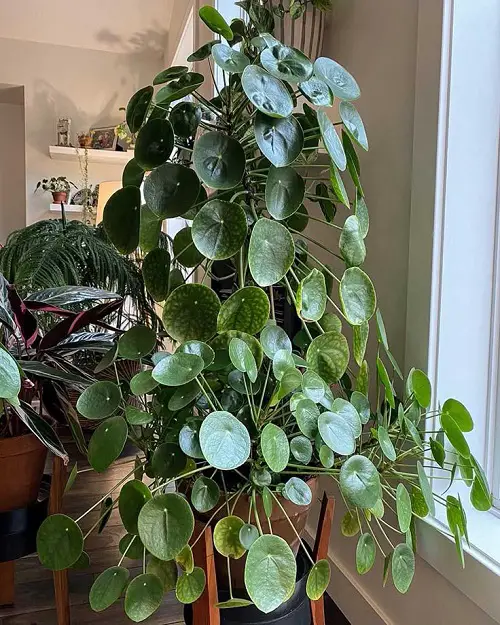
From minimalism to sci-fi fandom, this plant’s symmetrical, coin-like foliage, slender stems, and glossy, lush green hues satisfy all sleek decor needs.
It’s also known as the UFO plant for its extraterrestrial appearance and, more commonly, as a friendship plant because of its “easy to divide” and “best plant to gift” reputation.
And don’t miss the fact that it’s considered a plant of fortune in Fengshui due to its coin-shaped leaves, which is why it’s called a money plant!
How to Grow a Bushier Chinese Money Plant
Pilea is a superb houseplant for beginners. It is low maintenance, compact, grows well in containers, and looks spectacular with little effort. With the right care, it is most graceful at filling out space. A healthy plant produces ample pups—key to a wholesome look—which you can regrow, replant, and gift away happily.
However, even this resilient plant needs a few things done right to thrive, without which, its leaves won’t fully develop, its central stem may start getting bendy and irregular, and overall, the plant will grow leggy and sparse. And of course, won’t sprout any new pups either!
So, let’s address these misgivings and make sure our Chinese Money Plant only grows bushier and healthier to stay its eye-catching best!
Steps to Make Your Chinese Money Plant Bushier
1. Rotate for Ample Sun

Chinese money plants love bright, indirect light, but as we grow plants indoors, the light they receive may not be even on all sides. In search of light, your pilea will start stretching and bending, using up all resources actually meant for its moneymaker—the foliage!
It may also grow lop-sided, fuller where the light falls, and lanky where it doesn’t! Rotating the plant 90 degrees weekly ensures it gets even sunlight all over, so the central stem won’t start meandering in search of anything.
Instead, it can stay put and support the rest of the plant to encourage bushy growth. And if you just don’t have ample sun, simply use grow lights.
2. Propagate Pups Together
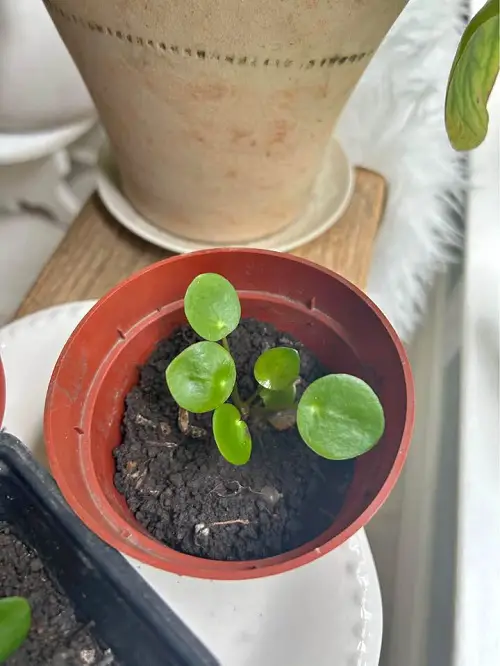
The mother plant, given all requirements are satisfied, will rapidly grow lush and full. But the best part is how quickly it produces pups that shoot up from the dirt with their own sets of tiny roots that go deep down.
Now, for a bushier Chinese money plant, leave them be! And they’ll automatically give the parent plant plenty of girth as they grow.
However, if you wish to move these pups to another sparse-looking pilea that isn’t the mother, gently cut these baby plants a few inches below the soil with some roots attached and stick them in a glass of water with dappled sunshine. Once you see the roots form, plant them around the target pilea after examining the pot size.
Repot if you find the current container too crammed! Choose one with good drainage, preferably add a layer of pebbles, then fresh potting soil, and then those baby plants. Next, let’s quickly talk about moisture before further details.
3. Perfect Hydration
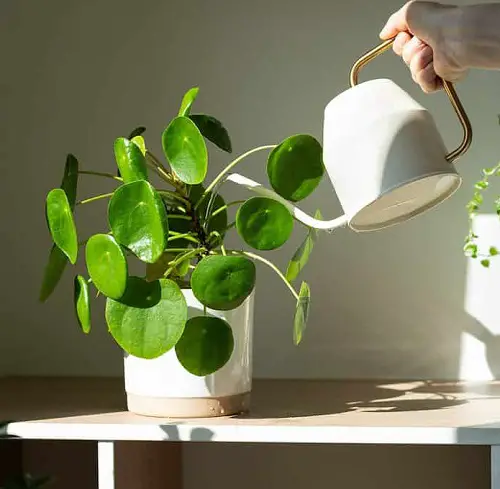
Now, this may seem like a generic plant care tip, but it’s crucial to growing a healthy and bushy pilea. This plant doesn’t like wet feet, and neither does it like its leaves and stems staying damp. The best way to hydrate is to target the roots.
If growing it in a cache pot, simply take out the original container, then set the pot on a tray of water for ten minutes, and you’re done. This bottom watering is perfect your pileas.
Pilea prefers the soil to dry out by a third between waterings. And this step ensures its roots hydrate perfectly. Now, here’s what to do if you have overwatered your pilea.
4. Regular Pruning
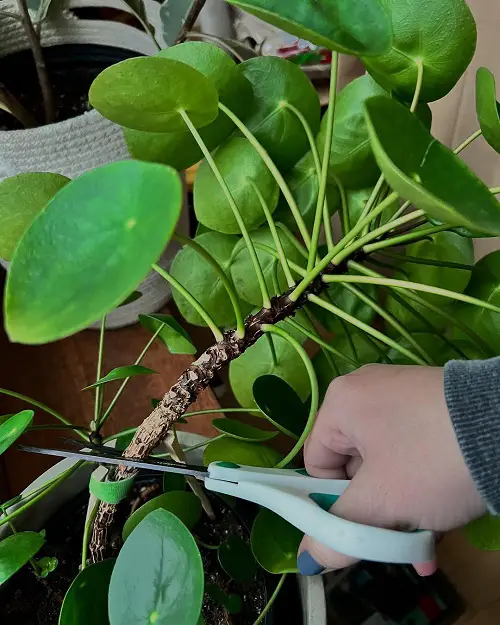
Trimming away old, excessive, withering leaves and branches helps sprout new growth, thus giving your Chinese money plant a luscious look.
If your plant has leggy and stretched stems, it’s investing its energy vertically instead of growing fuller. Look for such long bare growth and cut right above the leaf node. If the stem is too long with leaves only at the top, then cut 1/3 of its top growth to promote new branches.
To achieve fuller growth from the top, prune the leaves and stems that are growing outward.
Start of the growing season around spring is best for topping and removing excess growth, this allows the plant enough time to heal. However, you can do moderate pruning anytime during the growing season.
Pro Tip: When you are done with the prune, plant the pilea stems with at least one leaf node in the same container for a bushier appearance or propagate them together in a new pot.
5. Pinch More Often
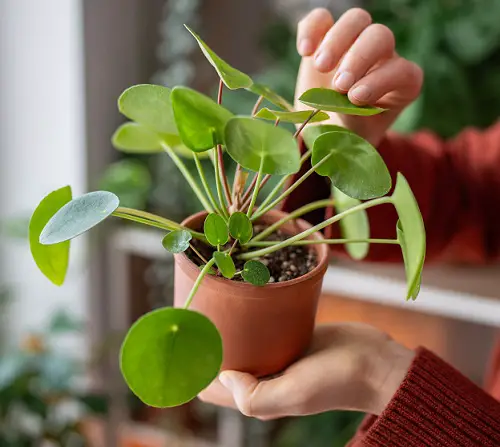
When we say pinch, we mean gently and manually, with your fingers, and not the tools! Pinching new growth, especially the topmost growing tips, redirects the plant’s energy and encourages lateral growth, making it look round and bushy!
Pinch the stem tips of new growth with about 2-3 leaves on top by holding it between your fingers and gently twisting to remove just above the leaf node. Do this every few weeks as the plant grows. And forget about using shears when doing this!
Since we are targeting fresh growth here, only do this if the growth is too vertical. Don’t remove more than 20 percent of the plant’s overall growth at any time. And wait for the plant to recover and settle before pruning and pinching again! It’s surgery, remember?
6. Fertilize Gently
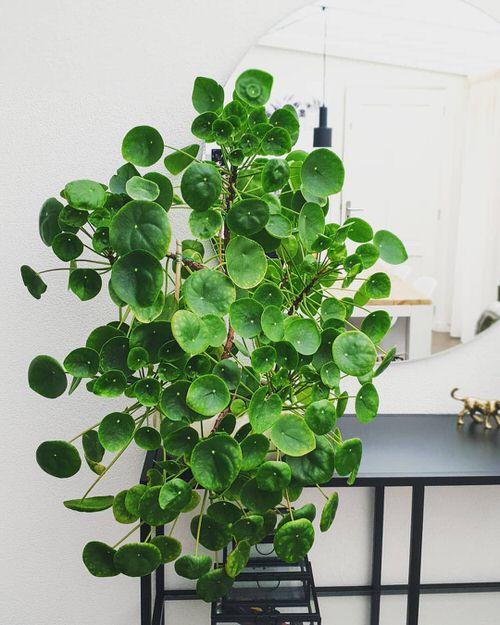
If you want to focus on bushy foliage on your Chinese Money Plant, use nitrogen-rich fertilizer. You can use compost or leaf mold which will ensure that your plant has healthy foliage growth and at the same time soil texture.
Feed it with a balanced liquid fertilizer diluted to one-quarter of its strength during its active growing season every 3 weeks.
7. Grow Them Together
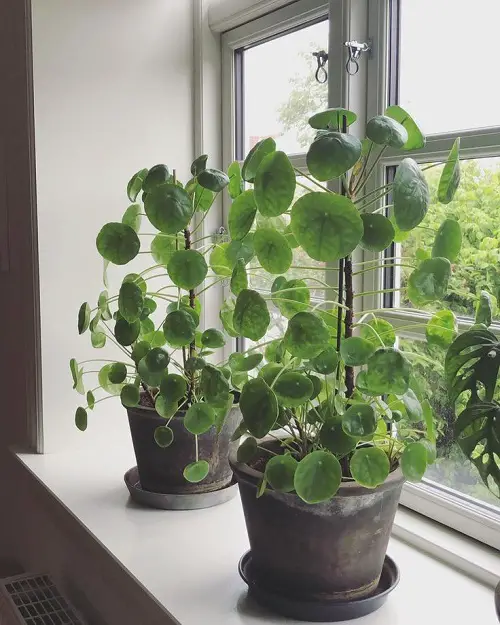
Despite its exceptional, superior appearance, this plant actually enjoys the company of other plants. While it looks perfect against a lone sunny window sill, it will be truly happy when grouped with other plants to create a microenvironment.
This will keep it cozy, humid, and protect it from dry or extreme fluctuations. And what’s better than a plant—several plants!
Group them with specimens with similar needs and preferences, such as peperomias or other pilea varieties. You can water these together without too much caution, and as this evaporates, it boosts air moisture that pilea adores.
Hope these tips help bring out the best and bushiest of your Chinese money plant. Before you go, also read this effective little guide on using nail clippers for bushier plants!


